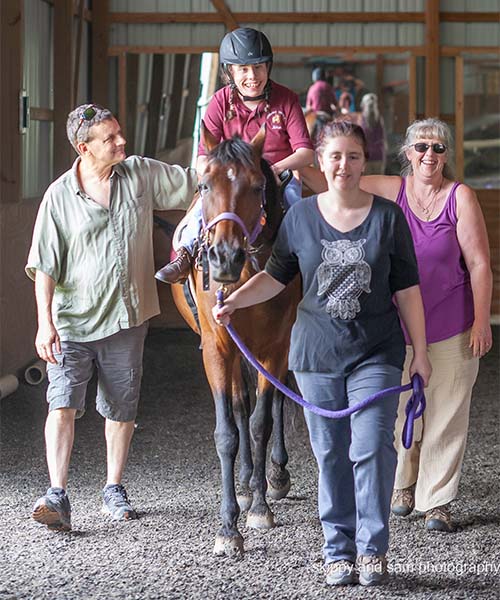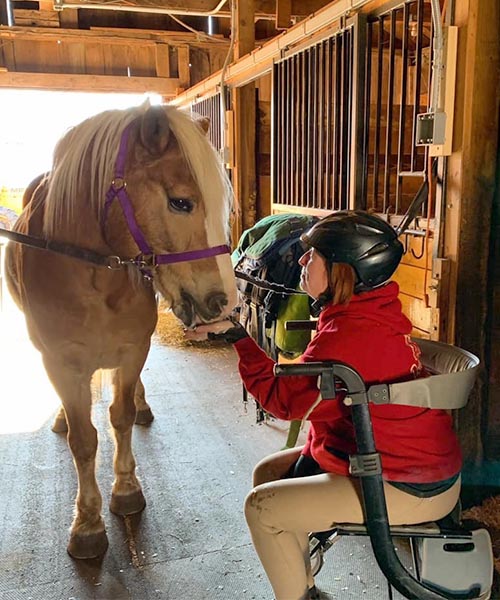
Combining a love of horses with a passion for helping people live their best lives, the Southern Vermont Therapeutic Riding Center (SVTRC) in Wilmington, VT, has been providing Equine Assisted Therapy Services within our region for the past decade. We sat down with Amber Thibodeau, the Executive Director and Head Instructor of the SVRTC, to learn more about the program and how they have impacted the community, truly changing the lives of the participants.
SVTRC provides the opportunity for children and adults in the community to connect with horses and learn more about their bodies and minds in the process. Participants with both physical and mental disabilities are able to discover that they are capable of more than they ever imagined, learning lessons that they can take with them into the world. “There is a joy here, between the horses, the riders, volunteers, and instructor. Such learning and growth, all while having fun!” exclaimed one of the family members of a rider.
Founded in 2010 by Lorna Young, a Professional Association of Therapeutic Horsemanship International (PATH Intl.) Certified Advanced Instructor, and Nicholas Mercede, the owner of a stable in Newfane, VT, SVTRC was a response to the growing need for Equine Assisted Services in Southern Vermont. After it was founded, progress moved quickly. In 2011, SVTRC received its accreditation from PATH Intl. and the next year it was reorganized as a nonprofit corporation. In 2016, SVTRC relocated from Newfane to Brookside Stables in Wilmington, VT, where they continue to operate today under Amber’s leadership. “We are blessed to have a great community of volunteers that believe in the mission and believe in the work that we do,” says Amber. “Some volunteers have been involved longer than I have.”

“The benefits of Equine Assisted Services and Therapeutic Riding are numerous and varied,” explains Amber. “Folks with physical disabilities or mobility differences often experience improved balance and coordination, increased range of motion, improved muscle tone and strength, and improved proprioception. Those with cognitive differences experience improved fine and gross motor skills, improved language skills, improved self-awareness, as well as increased ability to concentrate, plan, and sequence.” Other benefits include increased self-confidence, improved patience, and improved ability to develop a connection and relationship with another being. One of their long-term participants often shares her experience and sums up the benefits of therapeutic riding by saying, “I’m constantly reminded of what my body can’t do, and when I ride I’m reminded of what my body can do.”
Teaching 20-25 lessons a week during the spring and fall months (lessons tend to slow down during the summer and winter due to conditions that are exacerbated by extreme weather), SVTRC offers services to riders of all ages, from four years old and up. Their riders have a variety of disabilities, including autism, multiple sclerosis (MS), attention deficit hyperactivity disorder (ADHD), Rett Syndrome, and Down’s Syndrome. Their lessons are different depending on the individual needs and goals of each participant. “I love getting to see the big and little successes and achievements each of my participants achieves each lesson. And for every person, those milestones are different, but they’re all exciting,” Amber says with a smile. “This job also very rarely is boring; a lot of parts of my day are the same in big ways, but every day is different and each lesson is always different. Every participant is always excited to arrive- their lessons are often their favorite part of the week!”
I’m constantly reminded of what my body can’t do, and when I ride I’m reminded of what my body can do.
—SVTRC Participant
While the ages and health conditions of the riders vary, the vast majority have similar thoughts when it comes to the importance and impact of the program. Brenda, a parent of one of the participants, exclaims, “SVTRC has given my son Jasper the ability to learn to ride. He loves seeing Duke and riding him. They are providing him with lessons around things that will help him with his balance and strengthen his core. Amber is amazing to watch and provides an excellent program!”

The program has three hard-working horses who help the participants improve both their physical and mental health. “It takes a very special horse to be a therapeutic riding horse,” Amber explains. “We need very sane and very sound horses who can take on kids with balance issues and aids, while also supporting the riders who are walking, trotting, and canter, and working on lower level dressage tests.” Duke, a Morgan gelding; Bubbles, a pinto mare; and Carrot, a Haflinger gelding, are all quiet and easily adaptable to everything that Amber and the participants present them with, including mobility aids, walkers, wheelchairs, and mounting ramps.
“These incredible horses are the same every day,” Amber smiles. “They show up every day to do their job. They are not worried and not judgemental, the participants learn to trust them as the loving teachers that they are.”
The horses help their riders to reach new goals. “I just recently had one of my participants hit a big milestone–a few years ago, he had a significant hip surgery and has always used our adaptive mounting ramp to get on his lesson horse,” Amber tells us. “At his last lesson, I threw him a curveball (which in and of itself was a victory) and had him get on from the three-step mounting block. It wasn’t perfect, but he did it! It was a huge step not only for his physical strength and flexibility, but for his self-esteem.”

“Another story that I love to tell is about my now close friend Naomi,” she continues. “She has a complete spinal cord injury due to an ATV accident in 2005.” The accident left Naomi wheelchair-bound and thinking that horses would never be a part of her life again. “In 2016, she reached out looking for a program that would accept her as a participant. She had been an avid equestrian all her life and worked full time at a barn before her injury, and wanted to get back into riding. She rode with SVTRC for four years and still does occasionally, working to improve her balance, core, and overall strength. She now trail rides her personal horse, at home, independently!”
Despite its challenges, SVTRC was able to continue running its program throughout the COVID-19 pandemic. “We briefly thought we would have to close our doors for good,” Amber reflects. “We were able to secure Paycheck Protection Program (PPP) money and between that and the generosity of our supporters, we were able to stay afloat so that when we were able to reopen, we actually could. We started very gradually and methodically since many of our participants and even some volunteers are high-risk. So when we reopened, it was initially just for our independent riders. Then we progressed to participants who required minimal assistance/contact. Then, we welcomed back participants who required just a leader for their lessons, and then finally welcomed back participants who required more volunteer support. When we reopened, we adopted several protocols such as mask-wearing and contact tracing, and have been able to relax many of those protocols this year.”
As with many nonprofits, one of the biggest challenges is probably the financial aspect. It costs SVTRC more to run a lesson than they charge for a lesson fee, knowing that for many of their participants the lessons are a large part of their budget. To make up that difference, they depend on fundraisers, grants, and donations. “SVTRC is incredibly lucky to have very generous support from our community. We fundraise year-round to keep our program running and to subsidize lesson costs for our participants. Some of our annual fundraisers include our golf tournament, ice fishing derby, pizza sale, and silent auction. This year, we reinstated a fundraiser we haven’t done in many years called Walk-Trot Pedal and made it completely virtual. It was very successful so we hope to continue to do it annually,” Amber says.

In addition to the participants, many of the volunteers find the work to be extremely rewarding. “This has been a learning experience for me and I love it! I love seeing the kids transformed, I love following the instructor’s instructions, I love feeling so appreciated, and I love the horses and how well they are cared for,” remarked one grateful volunteer.
“One thing I wish more people knew about SVTRC and the services we offer is that firstly, it exists–I’ve been around horses my whole life and didn’t know about Equine Assisted Services and similar programs until I connected with SVTRC,” concludes Amber. “Now. I find myself surprised when others, even in the equine industry, don’t know these services exist or even how many programs there are around the country. Secondly, these services truly have an impact and make a difference in the lives of our participants.”
To learn more about the program or learn how you can become involved, we encourage you to visit the Southern Vermont Therapeutic Riding Center website.
